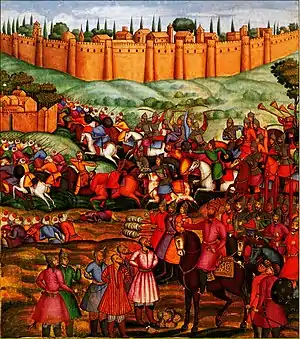Herat Campaign of 1731
The re-subjugation of Herat in the early 1730s took place during the height of the Ottoman–Persian War (1730–35) when Nader Shah who had already successfully driven the Ottomans from western Iran and southern Azerbaijan had to cut his campaign short to deal with the revolt of the Abdalis of Herat who were provoked into bearing arms against their Persian overlords by Hussein Hotaki of Qandahar. The conflict resulted in the re-establishment of Persian rule over Herat.
| Herat Campaign | |||||||||
|---|---|---|---|---|---|---|---|---|---|
| Part of the Ottoman–Persian War (1730–35) and Nader's Campaigns | |||||||||
 An illustration of the battle of Herat. The city's walls are clearly seen in the background. In this illustration, Nader's soldiers bring him prisoners and severed heads while Nader's soldiers finish off the Afghans and force them to flee. | |||||||||
| |||||||||
| Belligerents | |||||||||
|
| ||||||||
| Commanders and leaders | |||||||||
|
Nader Ibrahim Khan Allahyar Khan (up to September 1731) |
Zulfaqar Khan Mohammad Seidal Khan Allahyar Khan (after September 1731) | ||||||||
| Strength | |||||||||
| Unknown | Unknown | ||||||||
Zulfaqar Khan's Revolt
As the Persian empire set about re-incorporating the lost territories to the west, Hussein sultan of Qandahar intrigued the Abdalis of Herat to raise against their masters while the main Persian forces were arrayed against the Ottomans thousands of kilometres to the west. The governor of Herat, Allahyar Khan, who was confirmed in his position by Nader after his the war of in 1729 remained loyal but his chief lieutenant Zulfaqar Khan was very much taken by Qandahar's assurances and support.
The siege of Mashhad
Allahyar Khan was obliged to flee Herat and was given refuge by Nader's brother Ibrahim Khan. The Abdalis soon invaded Khorasan itself and marched on its capital, Mashad, defeating the Persian under Ibrahim Khan and forcing it to withdraw into the city walls which now came under siege. Although the Abdalis had little chance of actually taking the city as what little artillery they possessed would make hardly any impression on the battlements of Mashad, these events shook Nader who received word that his power base back in Khorasan was under threat. On August 16 Nader left Tabriz behind and marched his force across 2,250 kilometres over the Iranian plateau with lightning speed, bringing him to Mashad where he found the Abdalis in headlong retreat.
Siege of Herat
Hussein Hotaki was growing increasingly anxious about his position in Qandahar with Nader approaching Herat, prompting him to enter into negotiations with Nader in which he sent back a few captive Safavid princesses. Hussein sultan's support for his proxy, Zulfaqar Khan, however did not cease or even lessen - in fact a Ghilzai force of at least a few thousand strong commanded by Mohammad Seidal Khan was sent from Qandahar to support him.
The Persian army arrived during April 1731 in the town of Noghreh just a few short kilometres from Herat itself, whence they fanned out and to take hold of the towers and strongholds in Herat's environs. During one of these nights Nader's small entourage of a mere eight musketeers were trapped in an isolated tower when Seidal Khan carried out a surprise raid. Fortunately for Nader a unit of musketeers happened upon the Afghan cavalry encircling his tower and put the enemy to flight. At a later date after crossing over a bridge over Harrirud, the Persians beat back a large counterattack by the Afghans forcing them to retire behind the walls of Herat's citadel. On a particular night when Nader was resting in his tent, an Afghan cannon from the citadel walls fired a random shot, lobbing a round ball through the roof of the tent with it landing right next to Nader's bed as he was resting causing his followers to claim he had divine protection.
The final decisive engagement took place outside the city when Zulfaqar Khan and Seidal Khan agreed to a joint coordinated attack against the Persians. The attack was decimated when Nader sent a flanking force round the Afghans and himself rode directly against their front with a large body of cavalry. The defeat caused Seidal Khan's departure which in turn led to the remaining defenders of Herat asking for terms of submission.
Allahyar Khan's Betrayal
Under the treaty signed by both sides Allahyar Khan was returned his governorship of Herat with Zulfaqar Khan being exiled to Farah. Nader did not however militarily occupy the citadel - an action which would prove a terrible mistake when 4,000 fighters came down from Farah and stoked the fires of rebellion once more. Allahyar Khan was pressured despite his reluctance to join the revolt. Allahyar Khan was also exiled.
The siege of the citadel was hence resumed with the Afghan's sending peace emissaries once they realised their predicament. The negotiations lasted a long while but were eventually concluded, giving Zulfaqar Khan and his brother a chance to escape to Qandahar whilst Herat came under occupation but was surprisingly not looted or sacked by Nader's troops. Ibrahim Khan managed to conquer Farah, helping to pacify the region as a whole in addition to Nader's policies of forced migration for many of the tribes involved in the rebellion as well as incorporating many of their fighters into his own armed forces.